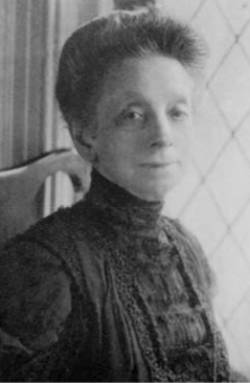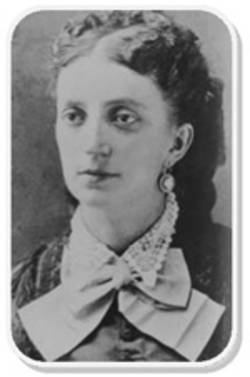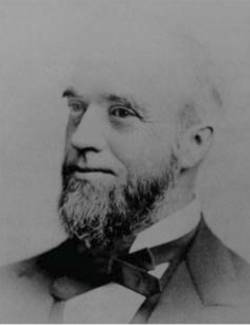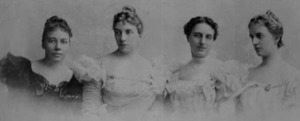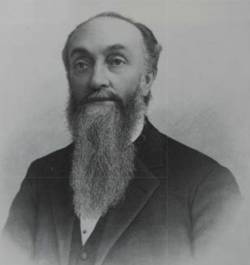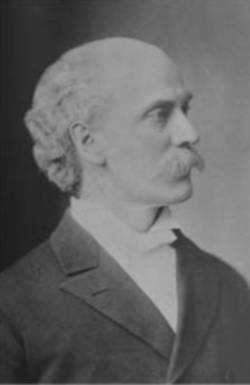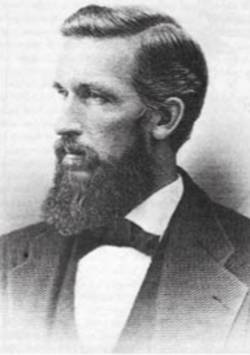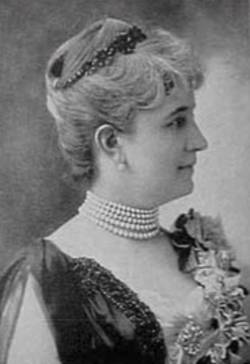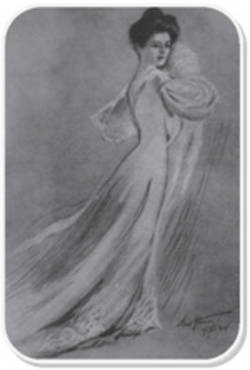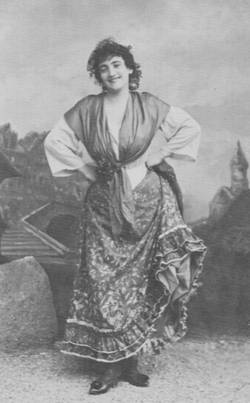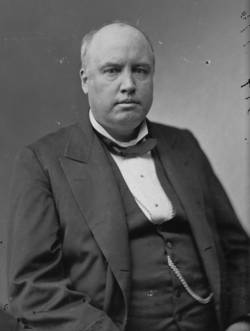People from Chicago associated with Swami Vivekananda
The Lyons
The Lyons belonged to the First Presbyterian Church. Mrs. Lyon had volunteered to host any broad minded delegate since Mr. Lyon was much interested in philosophy but heartily disliked bigots. Their home was at 262 Michigan Ave (now the Hilton Hotel) where they lived with their two sons John B. Jr. and William, a widowed daughter Mrs. Conger and 6 year old granddaughter Cornelia Conger. With Mrs. Lyon, who reminded Swamiji of his own mother, he visited the Women's Hospital of which she was the president. In his letter of October 2, 1893 to Prof. Wright Swamiji wrote, 'I am moving about just now. Only when I come to Chicago, I always go to see Mr. and Mrs. Lyon one of the noblest couples I have seen here.' Years later Cornelia Conger could remember Swamiji. Her reminiscences can be read in "Reminiscences of Swami Vivekananda"
The Hales
On September 10, 1893 the day before the Parliament was to begin Swamiji sat down, weary and exhausted, on the street-side when Mrs. Hale who lived in the house across the street noticed him and welcomed him into their home. The Hale family was to become more dear to Swamiji than any other he would know in the West. 'I scarcely find a family so highly pure and kind. Or why should God shower blessings on them in such abundance? Oh, how wonderfully kind they are!' he wrote to his brother disciples in 1894. From about the middle of November, 1893 the Hales' home on Dearborn Ave served as Swamiji's headquarters; Along with Mrs. and Mr. Hale, their household included two daughters Mary and Harriet Hale and two nieces Isabelle and Harriet McKindley. Swamiji addressed Mrs. Hale as Mother Church and Mr. George Hale as Father Pope.
The Hale and McKindley sisters were to him sisters or babies. "You are all so kind, the whole family, to me," he wrote to Mary Hale from India in 1898, "I must have belonged to you in the past as we Hindus say." Swamiji wrote more letters to Mary Hale than to anyone else in the West with the exception of Mrs. Bull. He wrote to Mary Hale in 1899, "It is curious, your family, Mother Church and her clergy, both monastic and secular, have made more impression on me than any family I know of. Lord bless you ever and ever."
Charles C. Bonney
Charles C. Bonney was a well-known judge in Chicago and the author of many important constitutional and economic reforms. He was the President of the World's Congress Auxiliary of the Columbian Exposition and it was Bonney's inspiration and idea to hold the Parliament of Religions as part of the Congress in order to, as he said in his welcome address, "unite all Religion against all irreligion; to make the golden rule the basis for this union; and to present to the world the substantial unity of many religions in the good deeds of religious life". Charles Bonney gave a huge reception in the upper floor and halls of the Art Institute (at that time known as the World's Congress Auxiliary Building) in the evening of September 12 for the delegates. Swamiji attended as reported by the Inter Ocean — "...Vivi Kananda [sic] came next and had a happy reception and was very much at home."
John H. Barrows
Rev. John Barrows was pastor of the 1st Presbyterian Church in Chicago and one of the city's most well known clergymen. As the chairman of the Parliament of Religions he was the principal organizer of the event. Swamiji met him at his house (2957 Indiana Ave) on September 10, 1893.
Elisha Gray
Elisha Gray was a famous electrical engineer and inventor who held over seventy patents to his credit. He was chairman of the Internal Electrical Congress, which had been held in conjunction with the Columbian Exposition, and his teleautograph machine to transmit facsimile was one of the exhibits in the Electrical Building at the Exposition.
Mrs. Potter Palmer
Mrs. (Bertha Honore) Potter Palmer headed the Board of Lady Managers of the Columbian Exposition. A very well known socialite and outspoken feminist, she was the official hostess of the Exposition. On September 22, 1893, in Hall VII of the Art Institute, Swamiji spoke on 'Women in Oriental Religion' at a special session organized by Mrs. Potter Palmer who was also the president of the Women's Branch of the World's Congress of the Exposition. Mrs. and Mr. Potter Palmer also gave a reception for the delegates on the evening of September 14 at the Women's Building in Jackson Park. At Mrs. Palmer's request Swamiji spoke on 'Condition of Women in India.'
Jane Addams
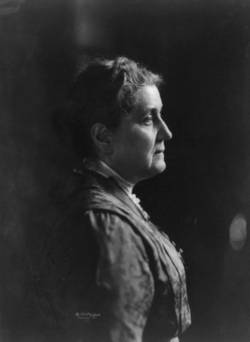
Jane Addams, social reformer, founder of Hull House. Credit. Library of Congress, digital ID cph.3a13016
Jane Addams reverently known in her circle as "Saint Jane" was a social reformer, peace activist, and with Ellen Gates Starr, the founder of Hull House - a social settlement whose main purpose was to provide social and educational opportunities for working class immigrants in the surrounding neighborhood. She shared the Nobel Peace Prize in 1931. She invited Swamiji to speak at the Hull House (800 S. Halsted) where he gave a talk on "Economic and Social Conditions in India". She also attended several of Swamiji's lectures in New York and Swamiji visited her at the Hull House during his visit to Chicago in 1899 during which time Sister Nivedita came to know her quite well. "Miss Adams as ever is an angel," Swamiji wrote of her in a letter to Betty Leggett.
Florence Adams
Mrs. (Florence) Milward Adams, a highly intellectual and versatile woman, was a popular lecturer on the Art of Expression and one of Swamiji's staunchest admirers in Chicago. He first met her in Sara Bull's house in Cambridge, MA in December, 1894. She was the principal force behind arranging lecture classes for Swamiji in Chicago since then. She lived at the Auditorium Hotel (at the northwest corner of Michigan Ave and Congress) and Swamiji held daily classes there during his stay in Chicago between January 1 and 17, 1895. He also held morning classes in her studio in Central Music Hall (then 69 State St. - at the southeast corner of State and Randolph) during his visit to Chicago in April, 1896. In a letter written from Chicago to Mrs. Bull he wrote "everything has been well arranged here thanks to the kindness of Miss Adams. She is so good and kind" and in a letter to Isabelle McKindley he wrote "give Mrs. Adams mountain high love and regard from me." Mrs. Adams also visited Swamiji during his stay at Ridgely Manor in 1899.
Emma Calvé
Emma Calvé was a celebrated French operatic soprano and was probably the most famous French female opera singer of the time. She first met Swamiji in November, 1899 when she was visiting Chicago with the Metropolitan Opera Company. Feeling 'greatly depressed in mind and body' at the death of her daughter she went to see Swamiji. "She is a great woman. I wish I saw more of her. It is a grand sight to see a giant pine struggling against a cyclone." Swamiji wrote of her in a letter to Betty Leggett. Swamiji saw a lot more of Emma Calve in 1900 during his European visit. Madame Calve wrote in her autobiography - 'It has been my good fortune and my joy to know a man who truly 'walked with God', a noble being, a saint, a philosopher and a true friend. His influence on my spiritual life was profound. He opened up new horizons before me, teaching me a broader understanding of truth. My soul will bear him eternal gratitude."
Robert Ingersoll
Sometime during the post-Parliament period Swamiji first met the celebrated agnostic orator Mr. Robert Green Ingersoll and discussed religious and philosophical matters with him. The evidence of Swamiji's admiration for this honest, forthright man can be found in his lecture in London in 1896 where he said, referring to a conversation he had with Mr. Ingersoll - "In America, there was a great agnostic, a very noble man, a very good man, and a very fine speaker". In reply to Ingersoll's philosophy of not bothering about other worlds and squeezing the orange of this life to the fullest, Swamiji remarked - "I agree with you entirely. I have some fruit, and I too want to squeeze out the juice. Our difference lies in the choice of the fruit. I want to understand the heart of things, the very kernel itself, your study is the manifestation of life, mine is the life itself. I must know the heart of this life, its very essence."
Harriet Monroe
Harriet Monroe was a poetess, the founder of "Poetry: A Magazine of Verse" and was the patron saint of the new American poetry of realism and imagery. She was the sister-in law of John Wellborn Root, the architect who shared the responsibility for the construction of the World's Fair with Daniel Burnham until his untimely death in 1891. She wrote the dedicatory poem "Columbian Ode" for the World's Columbian Exposition. She heard Swamiji at the Parliament of Religions and recollected her impressions in her autobiography "A Poet's Life":- "It was Swami Vivekananda, the magnificent, who stole the show and captured the town. His personality, dominant, magnetic; his voice, rich as a bronze bell; the controlled fervor of his feeling ; the beauty of his message to the Western world, it was human eloquence at its highest pitch."

